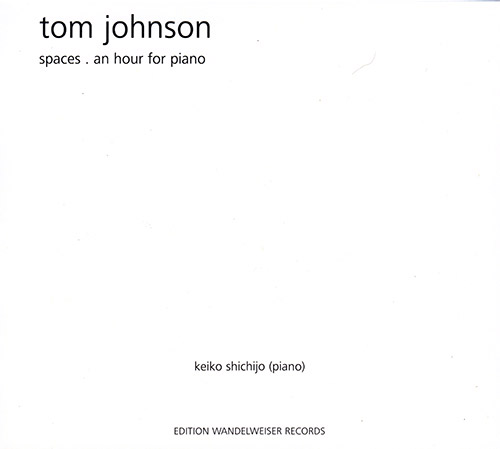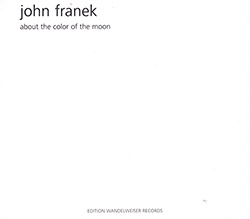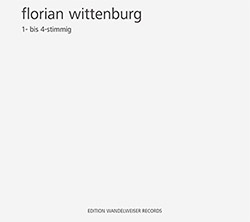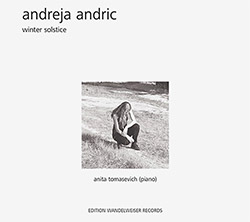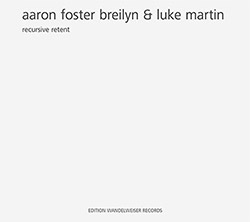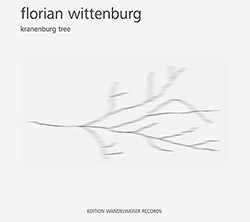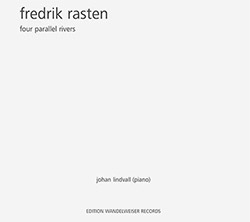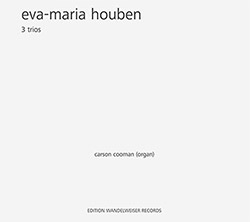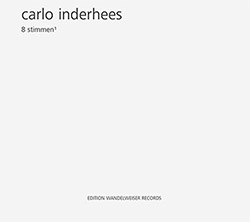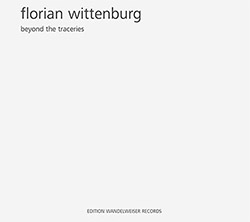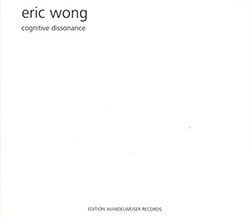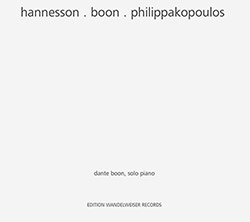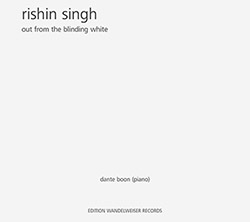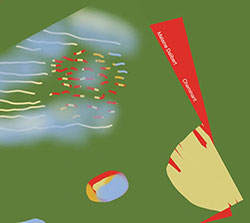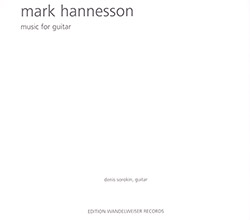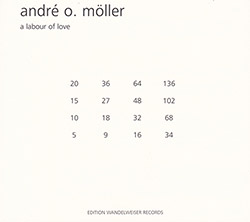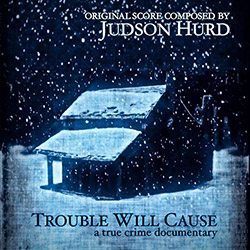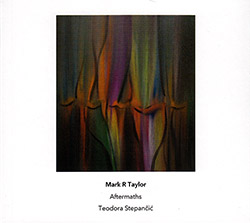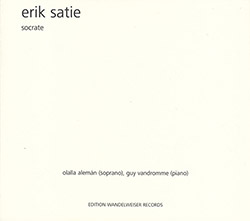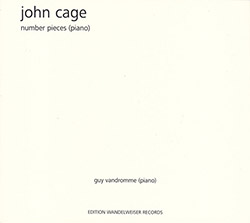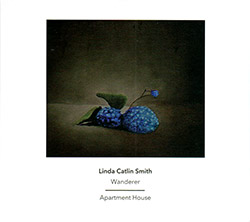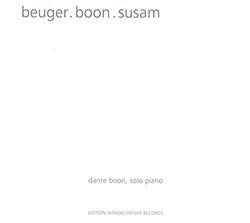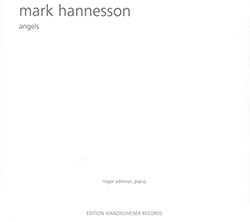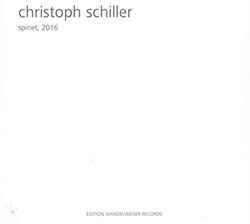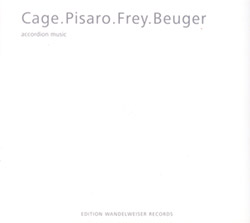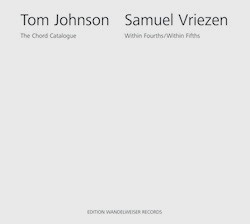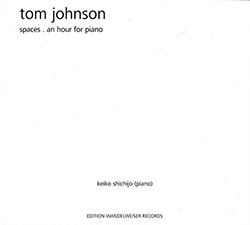
Two works for solo piano from composer Tom Johnson and performed by Keiko Shichijo; "Spaces" was written after his teacher, Morton Feldman, helped Johnson elucidate his voice as a composer through a study of chords; "An Hour for Piano" was written in 1971 based on a series of short, improvisatory sketches written for modern dance, merged and expanded to exactly one hour.
Out of Stock
Quantity in Basket: None
Log In to use our Wish List
Shipping Weight: 2.00 units
Sample The Album:
Tom Johnson-composer
Keiko Shichijo-piano
Click an artist name above to see in-stock items for that artist.
UPC: 4011778041047
Label: Edition Wandelweiser Records
Catalog ID: EWR 1808
Squidco Product Code: 26748
Format: CD
Condition: New
Released: 2018
Country: Germany
Packaging: Cardstock 3 page foldover in vinyl sleeve
Recorded at MIRY Concertzall, in Ghent, Belgium, on April 4th and 5th, 2018, by Michael Penson.
"When I was studying with Morton Feldman, at his home in New York City, in the late '60s, he talked a lot about the importance of finding exactly the right sound. Apparently I wasn't getting the point, so one day he tried a new tactic. "Tom, I have a suggestion. Don't write any music for a while. Just listen to harmonies and think about them, and bring me a little collection of chords."
This seemed easy at first, but of course, it is very difficult to make a selection when there are literally millions of possibilities. Everyday, when I would go back to the piano to look for my chords, I would change my mind, and I didn't know what to do. I couldn't go back to Feldman saying I was unable to do the assignment, or that I didn't think it was important. But of course, if I went back with chords that sounded a little like his music or Stravinsky's or someone else's, Feldman would hear immediately that I had not taken his suggestion very seriously.
After working on the problem for two or three weeks, I decided to take him a little collection of seven chords. They all sounded similar, but I liked them all, and I couldn't find any better solution. With some trepidation, I showed my chords to Feldman, who played them over about 10 times in different combinations, really listening, the way he always did, and the way he wanted me to. Finally he looked up and said, "you know, that's not bad. This is really your music. I think you learned a lot from this little exercise."
Feldman was never discouraging, but he did not pass along compliments very often either, and his positive reaction here was very meaningful to me. It was some months after this, when I no longer went to study with him, that these seven chords found their place as the beginning of a new piece that I decided to call "Spaces". I could also say that this was the beginning of my life as a real composer."-Tom Johnson, March 1994
"Tom Johnson's "An Hour for Piano" was written in 1971. The piece began as a series of short, improvisatory sketches in 1967 when Johnson was accompanying a modern dance class at New York University. Johnson gradually expanded these sketches and added transitions between them, writing a piece that is to be played in exactly one hour. Achieving this goal requires an absolutely steady tempo for the duration of the piece, which Johnson has set at quarter note = 59.225 beats per minute. The only recording that is exactly sixty minutes long was recently released by the Irritable Hedgehog label and performed by R. Andrew Lee.
"An Hour for Piano" is deceptively simple, with six basic textures that come and go at the composer's whim. There is no order to these textures, and the transitions between them blur significantly the boundaries between them. Kyle Gann writes, "It never deviates from the key of G, though some dissonant motives wash through from time to time. The pedal is held constantly, and 99 percent of the notes are in or just above the treble clef." The effect is one where the past and present become irrelevant and the listener experiences an almost eternal present.
In 1974, Johnson also wrote program notes to accompany the piece. These notes are meant to be read while listening to the work, and they encourage the listener to "not to allow the program notes to distract you from concentrating on the music. They are intended to increase your ability to concentrate on the piece, and not to distract from it." These lengthy notes mirror the composition in certain ways, with sentences and entire paragraphs that return frequently and with subtle alterations to the text. The effect is similar to Johnson's landmark article, "What is Minimalism Really About?"
While "An Hour for Piano" has not enjoyed the same level of recognition that other standard minimalist compositions have, it still "represents many of minimalism's best qualities while avoiding many of its pitfalls. It is an understated watershed of a composition - simple enough to understand on first hearing, complex enough to never fully comprehend, and important enough to usher in a new mode of composition." "-Wikipedia
Program notes from Tom Johnson to accompany the listening of "An Hour for Piano"
It is important that you try not to allow the program notes to distract you from concentrating on the music. They are intended to increase your ability to concentrate on the piece, and not to distract from it. If you find that reading the program notes does not increase your ability to concentrate on the music, you should not read further at this time. Perhaps, at some later time, you will find that reading the program notes will increase your ability to concentrate on the music.
Perhaps you are not sure whether the program notes are helping you to concentrate on the music or not. In order to determine whether they are helping you, you may wish to stop at the end of this paragraph, and see how clearly you can recall the music which you heard while you were reading the paragraph. If you can remember the music clearly, then perhaps the program notes are increasing your ability to concentrate on the music. If you can not remember the music clearly, it is probably because reading the program notes has been distracting you from listening to the music. If they have been distracting you, you should not read further at this time. Perhaps, at some later time, you will find that reading the program notes will increase your ability to concentrate on the music.
This paragraph occurs several times in the program notes. However, it will probably seem different each time, because you will be listening to different music each time. You may find it interesting to compare the effect that the paragraph has when it is read in different musical contexts. Perhaps you will find that sometimes this paragraph increases your ability to concentrate on the music and sometimes it does not. Perhaps it will be more helpful to you on first reading than in later readings. Or perhaps the reverse is true.
You may find it interesting to consider that the form of the piece is determined to a large extent by you, since you are free to read or not read the program notes at any time. If you read the program notes very quickly and do not look at them again, you will hear the piece in one way. If you read very slowly, thinking and listening as you read each sentence, you will hear the piece in a very different way. If you alternate between reading and not reading, you will hear the piece in another way. Many other patterns might be followed. Probably no two people would follow the same pattern. You may find it interesting to consider the pattern you have been following up to this point. Perhaps you will want to continue following the same pattern. Or perhaps you will want to change the pattern.
Perhaps you will find that some sections in the program notes increase your ability to concentrate on the music more than other sections. Perhaps you will find that the program notes increase your ability to concentrate on some sections of the music more than on others. Perhaps you will find that certain sections in the program notes are particularly helpful when read in conjunction with certain sections in the music. Perhaps you will find that the program notes increase your ability to concentrate on the music more when the music is rather constant than when it is changing. Or perhaps the reverse is true. Or perhaps the program notes are about equally helpful, regardless of whether the music is rather constant or whether it is changing. Perhaps you will find that certain sections in the program notes are not at all helpful, when read in conjunction with certain sections in the music.
If reading the program notes is not helping you to concentrate on the music, perhaps you should consider the possibility that you are reading too quickly or too slowly. Perhaps if you read the program notes more quickly or more slowly, they will be more helpful to you in increasing your ability to concentrate on the music. You may also wish to consider that the program notes may be more helpful to you if you do not read them continuously, but in sections. Perhaps if you stop reading from time to time, and listen to the music by itself for a while, you will find that the program notes will be more helpful to you when you return to them. You may also want to consider the length of the piece. The program notes are also rather long, but if you read them at a normal pace you will finish them long before you finish hearing the music. But if you read slowly, or if you stop from time to time, you may finish reading them about the same time the music finishes. You may find that the program notes do not increase your ability to concentrate on the music, regardless of how you read them. In that case, you should not read further at this time. Perhaps, at some later time, you will find that reading the program notes will increase your ability to concentrate on the music.
The music you are now hearing is probably very similar to some section you will hear later. You may find that it is more interesting to you now than it will be later. Or perhaps you will find that it will be more interesting later than it is now.
This paragraph occurs several times in the program notes. However, it will probably seem different each time, because you will be listening to different music each time. You may find it interesting to compare the effect that the paragraph has when it is read in different musical contexts. Perhaps you will find that sometimes this paragraph increases your ability to concentrate on the music and sometimes it does not. Perhaps it will be more helpful to you on first reading than in later readings. Or perhaps the reverse is true.
If you have been reading continuously up to this point, perhaps you should put the program notes down and listen to the music by itself for a while. If you have already done this, you may want to do it again. Perhaps you will find that you are able to concentrate on the music better when you are not trying to read at the same time. Perhaps you will find that you are able to concentrate on the music better when you are reading the program notes.
You may find it interesting to consider how many types of music you have already heard, or will hear. You may also find it interesting to consider how many different topics have been or will be discussed in the program notes. Some people might feel that there are only three different types of things in the music and eight or nine different types of things in the program notes. Some people might feel that there are eight or nine different types of things in the music and only a few different types of things in the program notes. Some people might count the different types of things very differently. Some people will probably have no interest in counting the number of different types of things in the music and in the program notes.
From time to time, you should ask yourself whether or not the program notes have been distracting you from the music. It is important that you try not to allow the program notes to distract you from concentrating on the music, as they are intended to increase your ability to concentrate on the music, and not to distract from it. If you find that attempting to read and listen at the same time is too difficult or too restricting, you should not read further at this time. Perhaps, at some later time, you will find that reading the program notes will increase your ability to concentrate on the music. If you find that the program notes are always distracting and never increase your ability to concentrate on the music, perhaps you will want to forget all about the program notes and never read any further. Or perhaps you will want to forget all about both the program notes and the music, and think about something completely unrelated to either. You may find it interesting to notice what sorts of thoughts cross your mind.
If the music you are now hearing is rather constant, you may find it interesting to consider when it will change. If the music you are now hearing seems to be changing, you may find it interesting to consider when it will begin to sound rather constant again. Perhaps you feel that the music is always rather constant. Or perhaps you feel that the music is always changing. Some people will probably have no interest in making such comparisons.
You may find that the music is distracting you from the program notes, and that you are not comprehending all the ideas you are reading. That is not important, since the program notes are intended to increase your ability to concentrate on the music and are not that important in themselves. But if you find that the program notes are distracting you from the music, you should not read further at this time. Perhaps, at some later time, you will find that reading the program notes will increase your ability to concentrate on the music.
The music you are now hearing is probably very similar to some section you will hear later. It may also be very similar to some section you have already heard. You may find that it is more interesting to you now than it will be later or than it was before. Perhaps it is less interesting to you now than it was or will be at some other time.
If the program notes are distracting you from the music, it may be because you are reading too slowly or too quickly. Perhaps, if you read more slowly or more quickly, the program notes will increase your ability to concentrate on the music. You may also wish to consider the length of the piece. You should be able to estimate roughly how long it will take you to finish reading them at your present rate, and about how much music will be left after you finish the program notes. Since you will probably not feel like rereading any of the program notes, you may wish to pace yourself so that you finish reading them about the same time the music finishes. Or perhaps you will want to finish the program notes and then listen to the music by itself. It is important to remember that the form of the piece is determined to a large extent by you.
This paragraph occurs several times in the program notes. However, it will probably seem different each time, because you will be listening to different music each time. You may find it interesting to compare the effect that the paragraph has when it is read in different musical contexts. Perhaps you will find that sometimes this paragraph increases your ability to concentrate on the music and sometimes it does not. Perhaps it will be more helpful to you on first reading than in later readings. Or perhaps the reverse is true.
Perhaps you will find that some sections in the program notes distract you from listening to the music more than other sections. You may find it interesting to consider which sections are the most distracting. Perhaps you will find that some sections in the music interest you more than other sections, regardless of what you may be reading in the program notes. You may find it interesting to consider which sections these are. Perhaps you concentrate on the music more when it is rather constant than when it is changing. Or perhaps the reverse is true. Perhaps you feel that the music is always rather constant. Perhaps you feel that the music is always changing. Some people will probably have no interest in making such comparisons.
It is important to remember that the program notes are intended to increase your ability to concentrate on the music, and not to distract from it. If you find it too difficult or too restricting to read and listen at the same time, you should not read further at this time. Perhaps, at some later time, you will find that reading the program notes will increase your ability to concentrate on the music.
If you are not sure whether the program notes are helping you to concentrate on the music or not, you may wish to stop at the end of this paragraph, and see how clearly you can remember the music which you heard while you were reading the paragraph. Since this same procedure was suggested earlier in the program notes, you may find it interesting to compare your ability to remember the music now with your ability to remember the music then. Perhaps you will be able to remember the music which goes with this paragraph better than you were able to remember the music which went with that earlier paragraph. Perhaps you were able to remember the music better when you read the earlier paragraph.
If you have been reading continuously up to this point, you should consider putting the program notes down and listening to the music by itself for a while. Perhaps you will find that you are better able to concentrate on the music when you are not attempting to read the program notes at the same time. Perhaps you will find that the program notes were increasing your ability to concentrate on the music, and that you will not be able to concentrate on the music as well when you are not reading the program notes. If you are able to concentrate on the music better when you are not reading the program notes, you should not read further at this time. Perhaps, at some later time, you will find that reading the program notes will increase your ability to concentrate on the music. If you find that the program notes are always distracting, you may not want to read the remaining paragraphs at all.
It is important to remember that the form of the piece is determined to a large extent by you, since you are free to read or not read the program notes at any time. If you have been alternating between reading and not reading, you have been hearing the piece in one way. If you have been reading continuously up to this point, you have been hearing the piece in another way. If you are now reading more quickly or more slowly than when you began, that too would affect the way you have been hearing the piece. Perhaps you will want to continue reading the program notes in the same way. Or perhaps you will want to change the pattern.
The following paragraph has already occurred in the program notes three times. Perhaps the idea of reading it a fourth time will not appeal to you. If so, you may want to read it very quickly this time. Or perhaps you will want to skip it entirely. But if the idea of reading it a fourth time does not seem too difficult or too restricting, you may want to read it again in much the same way you read it before. Perhaps, since you are now very familiar with it, you will find that it does not distract you from the music as much as it did before. Or perhaps you will find that it is more distracting than before. You may also find that it is more difficult to comprehend and relate to than it was when you read it before.
This paragraph occurs several times in the program notes. However, it will probably seem different each time, because you will be listening to different music each time. You may find it interesting to compare the effect that the paragraph has when it is read in different musical contexts. Perhaps you will find that sometimes this paragraph increases your ability to concentrate on the music and sometimes it does not. Perhaps it will be more helpful to you on first reading than in later readings. Or perhaps the reverse is true.
Now that you are approaching the end of the program notes, you may want to consider the length of the piece. You should be able to estimate roughly how long it will take you to finish reading the program notes at your present rate, and about how much music will be left after you finish reading them. Since you are free to read or not read the program notes at any time, the form of the piece is determined to a large extent by you. Perhaps you will want to stop reading at this point, and return to the remaining paragraphs when you think the piece is about to finish. Perhaps you will want to continue reading at your present rate. Or perhaps you will want to read the remaining paragraphs more slowly or more quickly. How you experience the last part of the piece will be determined partly by the pattern you choose for reading the last part of the program notes.
The music you are hearing now is probably very similar to some section you heard earlier. You may find that it is more interesting to you now than it was before. Or perhaps it was more interesting to you then than it is now.
In order to determine whether the program notes have been increasing your ability to concentrate on the music, you may find it interesting to see how clearly you can remember all the music you have heard up to this point, and how clearly you can remember all the program notes you have read up to this point. If you can remember the music more clearly than you can remember the program notes, the program notes have probably been helping you to concentrate on the music. If you can remember what you have read more clearly than you can remember what you have heard, the program notes have probably been distracting you from the music, and you should not read further at this time. Perhaps, at some later time, you will find that reading the program notes will increase your ability to concentrate on the music.
When you finish reading the program notes, you may wish to consider how much of the piece remains to be played, and how you will want to listen to the music once you have finished the program notes. If the program notes have increased your ability to concentrate on the music you may want to reread parts of them. Perhaps, if you do reread parts of them, they will continue to increase your ability to concentrate on the music. Probably you will not feel like rereading the program notes, and will want to put them down and listen to the music by itself. Perhaps you will find that you will be able to concentrate on the music better after you have finished reading the program notes. Or perhaps you will find that you will continue to think about the program notes, even though you have finished reading them. Or perhaps you will want to think about something completely unrelated to either the music or the program notes. You may find it interesting to notice what sorts of thoughts cross your mind.
-- Tom Johnson (1974)
Artist Biographies
• Show Bio for Tom Johnson "Tom Johnson (born November 18, 1939 in Greeley, Colorado), is an American minimalist composer, a former student of Morton Feldman. He earned his Bachelors and Masters degree from Yale University. His pieces are most often based simply on mathematical and logical processes, such as tiling, which he attempts to make as clear as possible. His works include: The Four Note Opera, An Hour for Piano, Rational Melodies, the Bonhoeffer Oratorio, Organ and Silence, Riemannoper, and Galileo. He has also composed a considerable amount of music for the guitar including Alexandrins pour guitare (1989), Canon for Six Guitars (1998), Arpeggios for Guitar (2002), and Tinkelenberg Rhythms (2014). Johnson received the French "Victoires de la Musique" prize for contemporary composition (the French equivalent of the "Grammies") in 2001 for "Kientzy Loops". He lived 15 years in New York, but in 1983 settled in Paris, where he lives with his wife, the artist Esther Ferrer." ^ Hide Bio for Tom Johnson • Show Bio for Keiko Shichijo "Pianist & fortepianist Keiko Shichijo is a special voice in both the Classical and new music worlds. Her traditional Japanese sensibilities combined with her knowledge of European historical performance practices shape her unique vision, and this is reflected in her feeling for the music, the instruments and the story behind them. Hailing from Japan and residing in the Netherlands for more than a decade, she is active around the world playing both solo and chamber music. She is a prizewinner in many international competitions, including twice the International Early Music Competition (solo and duo) in Brugge, Belgium, the International Early Music Competition "A Tre" in Trossingen in Germany and the Minkoff Prize from the music publisher, Edition Minkoff, and has performed in many international festivals such as the festivals Printemps Des Arts (France), Utrecht Oude Muziek Festival (Holland), MA Festival (Belgium), La Folle Journée Tokyo (Japan). In 2012, the Hamamatsu Museum of Musical Instruments in Japan released her first fortepiano solo CD of works by Schubert. Her second solo CD "6 Dances by Komitas Vardapet", released in 2016, earned unanimous praise in the international press and was featured on the national Dutch TV program Vrije Geluiden. Keiko Shichijo has a violin/fortepiano duo with renowned violinist Cecilia Bernardini which performs regularly throughout Europe. As a specialist in contemporary music Keiko has worked with many composers, including Helmut Lachenmann, Tom Johnson, Johannes Kalitzke, Jürg Frey, Roscoe Mitchell en Bernhard Lang. Recently she premiered a concerto with the Janacek Philharmonic." ^ Hide Bio for Keiko Shichijo
4/22/2024
Have a better biography or biography source? Please Contact Us so that we can update this biography.
4/22/2024
Have a better biography or biography source? Please Contact Us so that we can update this biography.
Track Listing:
1. Spaces 15:09
2. An Hour For Piano 54:36
Compositional Forms
Avant-Garde
Piano & Keyboards
Solo Artist Recordings
Ambient & Minimal Music
New in Compositional Music
Search for other titles on the label:
Edition Wandelweiser Records.


